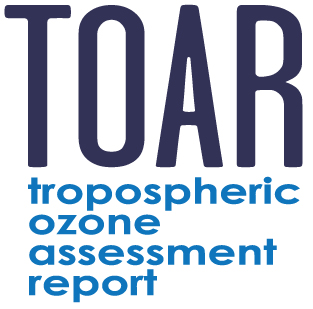Human Health Impacts of Ozone Focus Working Group

Co-Leads: Jason West, Univ. of North Carolina, USA, jjwest @ email.unc.edu
Gaige Kerr, George Washington University, USA, gaigekerr @ gwu.edu
Steering Committee Liaison: Erika von Schneidemesser, Research Institute for Sustainability, Potsdam, Germany, evs @ rifs-potsdam.de
Established: August 28, 2022
Scope Within TOAR-II
The health impacts of ozone are a primary motivating factor for studying tropospheric ozone generally, and for TOAR-II, as ozone contributes to hundreds of thousands of premature deaths globally and annually, in addition to morbidity effects. In TOAR-I, a focus on health led to an analysis of trends in ozone-related metrics at observational stations globally (Fleming et al., 2018). During TOAR-I and in the years since, research has emphasized using geostatistical data fusion (DeLang et al., 2021) and machine learning methods (Sun et al., 2022) to estimate global distributions of ground-level ozone for health-relevant metrics. These estimates supported global estimates of ozone-related deaths, and estimate that well over 90% of the world’s population is exposed to ozone in excess of the new World Health Organization guidelines.
A new working group on health will focus on estimates of ground-level ozone through use of TOAR-II observations as well as other data sources, for health-related metrics and for the purposes of understanding and quantifying the health impacts of ozone at present, in past trends, and under future conditions. We expect to interact with other working groups also analyzing ground-level concentrations, including the working groups on satellites, chemical reanalyses, and machine learning. Further, a working group on health can be a forum for developing new activities related to health, including on topics of trends, health impact assessment methods and applications, and epidemiology.
Objectives of the Focus Working Group
Overall, this Focus Working Group intends to convene researchers to discuss ozone-related health impacts and how TOAR-II observations, as well as other available datasets such as satellite observations and computer models, can help in understanding and quantifying ozone’s health impacts.
In addition to this overall goal, the Working Group intends to conduct a study that will lead to a published paper on an intercomparison of global ground-level ozone estimates for ozone health-relevant metrics. It is currently not known the extent to which different global ozone estimates created by different methods agree or disagree with one another. Here we aim to compare recent estimates from geostatistical data fusion, machine learning, and chemical reanalyses to better understand their differences in estimates of health-related metrics. This intercomparison will include an evaluation with respect to ground-level observations from the TOAR-II database. We will invite the creators of these different datasets to join the Focus Working Group.
Expected Outcomes
- Analysis quantifying the differences in global ozone ground-level concentration estimates for health-related ozone metrics, which will be written as a journal article for the TOAR-II Community Special Issue.
- Discussions of ozone-related health impacts and opportunities for this Working Group to conduct analyses relevant for the health impacts of ozone using the TOAR-II database, leading to additional publications.
Proposed Timeline
- Summer 2022 – Solicit participation in the working group, identify co-chairs as appropriate.
- – Gather relevant ground-level ozone datasets (machine learning, geostatistics, and chemical reanalyses) and plan the intercomparison with one another and evaluation with TOAR-II observations.
- Fall 2022 – Plan a first meeting to discuss possible directions, and initiate quarterly virtual meetings after that.
- Summer 2023 – Present results of the intercomparison to Working Group members.
- Fall 2023 – Submit a paper on the ozone intercomparison to the TOAR-II Community Special Issue.
Statement on open data practices and funding: TOAR is committed to open data practices and all Focus Working Groups will follow COPDESS (Coalition on Publishing Data in the Earth and Space Sciences) principles: http://www.copdess.org/statement-of-commitment/. The Focus Working Group leads and members are aware that participation with this working group is on a voluntary basis and that no funding is provided by TOAR-II.
References
DeLang, M. N., J. S. Becker, K.-L. Chang, M. L. Serre, O. R. Cooper, M. G. Schultz, S. Schroder, X. Lu, L. Zhang, M. Deushi, B. Josse, C. A. Keller, J.-F. Lamarque, M. Lin, J. Liu, V. Marecal, S. A. Strode, K. Sudo, S. Tilmes, S. Cleland, E. Collins, M. Brauer, J. J. West (2021) Mapping yearly fine resolution global surface ozone through the Bayesian Maximum Entropy data fusion of observations and model output for 1990-2017, Environmental Science & Technology, 55, 4389-4398, doi: 10.1021/acs.est.0c07742.
Fleming, Z. L. et al. (2018) Tropospheric Ozone Assessment Report: Present-day ozone distribution and trends relevant to human health, Elementa: Science of the Anthropocene 6..
Sun, H., Y. M. Shin, M. Xia, S. Ke, M. Wan, L. Yuan, Y. Guo, A. T. Archibald (2022) Spatial resolved surface ozone with urban and rural differentiation during 1990-2019: a space-time Bayesian neural network downscaler, Environmental Science & Technology, 56, 7337-7349, doi: 10.1021/acs.est.1c04797.